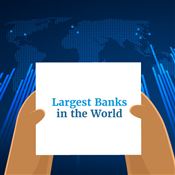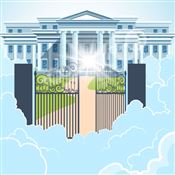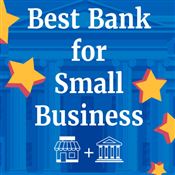Largest Banks in the US
Ad Disclosure: This article contains references to products from our partners. We may receive compensation if you apply or shop through links in our content. This compensation may impact how and where products appear on this site. You help support CreditDonkey by using our links.
A list of the largest banks in the US was released. Which banks came out on top? Read on to find out, plus the benefits of working with a big bank.
 |
Here's a list of the 20 largest banks in the US by assets:
The Federal Reserve provides a list of the largest banks in the U.S. But, given how fast-paced the industry is, a single merger or wrong investment can change the rankings of these financial giants.
For instance, the recent collapse of Silicon Valley Bank and First Republic Bank both impacted the list. First Citizens Bank bought out Silicon Valley Bank while JP Morgan Chase acquired First Republic Bank, leading to changes in their asset sizes.
With that, let's check out the largest banks in the U.S. (based on the most recent Federal Reserve Statistical Release), their assets, and what it took for them to get there.
Since larger banks have more customers, they're much more convenient when you want to access your money. They have more physical ATMs and bank branches compared to smaller banks. They can also have a wider variety of services because they cater to a wider variety of people.
JPMorgan Chase
Chase Bank (the banking branch of JPMorgan) is the largest bank in the US, with over $3.20 trillion in assets.
It's the only bank to have a physical presence in all 48 contiguous states. It has over 5,000 branches and 15,000 ATMs - more than any other bank in the nation.
JP Morgan is also a major provider of investment banking services. They actually operate the largest investment bank in the world by revenue.
Recently, JP Morgan has been looking more into AI research to see how it can help predict unseen situations and make banking safer. They also prioritize understanding customer needs in order to improve their services.
Chase Business Complete Banking® - Up to $500 Bonus
- Earn up to $500 when you open a new Chase Business Complete Checking® account. For new Chase business checking customers with qualifying activities.
- Get added features at no additional costs. Choose Chase Business Complete Banking® to get a fully integrated business solution that can help you control costs. Waive the $15 Monthly Service Fee in multiple ways like keeping a minimum $2,000 balance, plus use built-in offerings such as card acceptance, invoicing, Chase Customer Insights and Tap to Pay on iPhone at no additional cost.
- Bank with confidence. Feel confident knowing we have the largest branch network in the U.S. with 5,000 branches that provide personalized service and can help with your complex banking needs. You can also benefit from our account protection services, which provide safeguards by overseeing employee account activity, monitoring checks, and offering additional protection for your business.
- Access top-rated online business banking. Take advantage of our #1-ranked online small business banking platform with a comprehensive set of features designed for small business owners like you. Our tools enhance your ability to manage cash flow, accept and make payments, create invoices and plan for growth, so you can streamline processes and gain greater control of your finances.
Chase Private Client Checking℠ - Up to $3,000 Bonus
- Earn $1,000 when you deposit $150,000 - $249,999 or
- Earn $2,000 when you deposit $250,000 - $499,999 or
- Earn $3,000 when you deposit $500,000+
INVESTMENT AND INSURANCE PRODUCTS: •
Chase Total Checking® - $300 Bonus
Enjoy $300 as a new Chase checking customer, when you open a Chase Total Checking® account and make direct deposits totaling $500 or more within 90 days of coupon enrollment. Terms and conditions apply.
The information for Chase Total Checking® has been collected independently by CreditDonkey. The details on this page have not been reviewed or provided by the bank.
The number 1 bank in the world is Industrial & Commercial Bank of China Limited. They currently have assets totaling $5.7 trillion.
Bank of America
Bank of America has over 68 million customers and over $2.51 trillion in assets. They currently serve around 10.73% of all American bank deposits. They make banking convenient with thousands of ATMs and financial centers.
Its primary financial services revolve around commercial banking, wealth management, and investment banking.
In 2022, Bank of America was even named World's Best Bank by Euromoney.[1]
After surviving the 2008 global financial crisis, Bank of America shifted to focus on sustainable growth. They do this by: maintaining operational excellence, supporting employee well-being, and sharing success with their communities.
Bank of America Advantage Banking - Up to $500 Cash Offer
- The cash offer up to $500 is an online only offer and must be opened through the Bank of America promotional page.
- The offer is for new checking customers only.
- Offer expires 1/31/2026.
- To qualify, open a new eligible Bank of America Advantage Banking account through the promotional page and set up and receive Qualifying Direct Deposits* into that new eligible account within 90 days of account opening. Your cash bonus amount will be based on the total amount of your Qualifying Direct Deposits received in the first 90 days.
Cash Bonus Total Qualifying Direct Deposits $100 $2,000 $300 $5,000 $500 $10,000+ - If all requirements are met 90 days after account opening, Bank of America will attempt to deposit your bonus into your new eligible account within 60 days.
- Bank of America Advantage SafeBalance Banking® for Family Banking accounts are not eligible for this offer.
- Additional terms and conditions apply. See offer page for more details.
- *A Qualifying Direct Deposit is a direct deposit of regular monthly income – such as your salary, pension or Social Security benefits, which are made by your employer or other payer – using account and routing numbers that you provide to them.
- Bank of America, N.A. Member FDIC.
Bank of America® Business Advantage Banking - $400 or $750 Cash Bonus Offer
- The $400 or $750 cash bonus offer is an online only offer and must be opened through the Bank of America promotional page.
- The offer is for new eligible business checking customers only.
- Offer expires 12/31/2026.
- To qualify, a new Business Advantage Relationship Banking or Business Advantage Fundamentals™ Banking account through the promotional page and deposit New Money* directly into that new eligible account within thirty (30) days of account opening (“Deposit Period”). At the
end of the Deposit Period, all New Money deposits made directly into new eligible Business Advantage Banking account will be totaled to determine which Balance Requirement you have met and which corresponding Cash Bonus Tier you
are eligible for.
Balance Requirement Cash Bonus Tier $5,000 $400 $15,000 $750 - Maintain a daily balance in that new Business Advantage Banking account that meets the applicable Balance Requirement during the Maintenance Period**
- After you satisfy all of the requirements, Bank of America will attempt to deposit your earned bonus directly into your new eligible Bank of America Business Advantage Banking account within 60 days.
- Additional terms and conditions apply. See offer page for more details.
- *New Money is new funds deposited into your Business Advantage Banking account that are not transfers from other Bank of America accounts or Merrill investment accounts.
- ** The Maintenance Period begins thirty-one (31) calendar days after account opening and ends ninety (90) calendar days after account opening.
- Bank of America, N.A. Member FDIC
Business Advantage Relationship Banking
- Best for businesses with the need for extra accounts and robust banking needs.
- No fee for incoming wire, stop payment, electronic deposits and more.
- No fee for first 500 transactions per statement cycle.
- No fee for the first $20,000 in cash deposited per statement cycle at an ATM or Financial Center.
- Bank of America, N.A. Member FDIC
Citibank
Citibank is the primary U.S. banking subsidiary of Citigroup. They are worth over $1.77 trillion in assets.
They have over 600 locations in the US and more than 1,800 branches outside of the country. Plus, there are over 65,000 fee-free ATMs nationwide.
In 2022, Citi started investing more in digitalization as a long-term goal to provide a better platform for their customers. They're also looking into investing in robotics and automated processes.
They offer the same services that other traditional banks offer, like personal banking and loans.
Checking with Enhanced Direct Deposit - $325 Cash Bonus
Earn a $325 cash bonus when you open a new eligible checking account with Enhanced Direct Deposit and complete required activities. Deposit at least two Enhanced Direct Deposits directly into your new checking account within 90 calendar days from account opening. Your total combined Enhanced Direct Deposit must equal $3,000 or more. Your cash bonus will be deposited to your open, eligible checking account within 30 calendar days after required activities have been completed.
Citibank Business Checking - Up to $2,000 Bonus
Earn up to $2,000 cash bonus with required activities. Open a new CitiBusiness (Analyzed), Streamlined, or Flexible Checking account. Mention this offer to a Citibank Business Specialist. Within 45 calendar days following account opening, make one or more deposits in new-to-Citibank funds to meet the Qualifying Balance. Maintain the required Qualifying Balance for 45 consecutive calendar days after the Qualifying Balance level is met during the initial 45 calendar day funding period.
| Qualifying Balance | Bonus |
|---|---|
| $5,000 - $19,999 | $300 |
| $20,000 - $49,999 | $500 |
| $50,000 - $99,999 | $1,000 |
| $100,000 - $199,999 | $1,500 |
| $200,000 or more | $2,000 |
Citi Checking - $1,500 Bonus
Open a new Regular Checking account and enroll in this offer the same day the account was opened. Deposit at least $200,000 of new-to-Citibank funds into your new checking account within 45 days of account opening. Maintain $200,000 or more in the account for an additional 45 days after the first 45 days.
Wells Fargo
Wells Fargo is the result of a merger between the original Wells Fargo & Company and Norwest Corporation in 1998. It is the fourth-largest bank in the United States by total assets.
Wells Fargo's total assets were approximately $2.01 trillion in the third quarter of 2025. With over 11,000 ATMs and approximately 4,100 retail banking branches, they are able to effectively cater to their 70 million customers.
It's also one of the largest SBA lenders in the country, so it's a great option for small business owners.
Wells Fargo Everyday Checking Account - $325 Bonus
- Get a $325 new checking customer bonus when you open an Everyday Checking account and receive $1,000 or more in qualifying direct deposits.
- Wells Fargo Bank, N.A.
Member FDIC
U.S. Bancorp
U.S. Bancorp is the parent company of U.S. Bank. They have over $675 billion in assets.
With over 4,700 ATMs and 2,000 branches, it's no wonder they made it to this list.
They offer banking, investment, mortgage, trust, and payment services products.
Inspired mainly by the other tech giants currently emerging, U.S Bancorp has plans to partner with other fintech to improve their systems and remain competitive for their banking services.
Truist Financial Corporation
In 2019, a merger between BB&T and SunTrust formed Truist Financial Corporation. Now, they have over $574 billion in assets. And they span 17 states and Washington, D.C., with more than 2,700 branches and 3,000 ATMs.
Their services include consumer and commercial banking, securities brokerage, asset management, mortgage, and insurance products and services.
And just last year, they launched their robo-investing services - Truist Invest and Truist Invest Pro. These help clients create a personalized portfolio and essentially manage it for them.
Truist Bank: Personal Checking Account - $400 Bonus
Open a new Truist One Checking account online. Use promo code DC400TR1Q425 at account opening. Set up and receive at least two qualifying direct deposits totaling $2,000 or more within 120 days of account opening. Complete at least 20 qualifying debit card purchases within 120 days of account opening.
The information for Truist One Checking Account has been collected independently by CreditDonkey. The details on this page have not been reviewed or provided by the bank.
PNC Financial Services
PNC Financial Services, a subsidiary of PNC Bank, has $557 billion in assets. Originally an East Coast regional bank, it extended its footprint after acquiring BBVA in 2021.
Now they have approximately 2,400 locations in 28 states and over 60,000 PNC and PNC partner ATMs from coast to coast.
Other than traditional banking services, PNC also provides asset management, wealth management, estate planning, loan servicing, and information processing.
PNC invests billions annually in product and technology development enterprise-wide. It even opened iLab in 2015, where they develop new technology, space design, and other processes and operations.
Virtual Wallet with Performance Select Checking - $400 Bonus
Open a new Virtual Wallet with Performance Select checking account and make qualifying direct deposits totaling $5,000 or more within 60 days of account opening. Bonus will be awarded within 60-90 days of meeting the requirements.
Goldman Sachs
Goldman Sachs has over $490 billion in assets. It's an investment banking, management, and securities firm. They also invest in and arrange financing for startups.
They have several headquarters in Manhattan, London, Warsaw, Bangalore, Tokyo, Hong Kong, Salt Lake City, and Dallas.
In 2016, they launched an online bank called Marcus by Goldman Sachs, offering savings accounts with high APYs for individuals. They also have a robo-advisor service called Marcus Invest.
The online bank has no physical branches or ATMs.
Capital One
Capital One has $469 billion in assets. They offer around 1880 ATMs, over 290 branches, and 50 cafe locations.
Yeah, you read that right! They have cafe locations. But what are those?
It is a community space where you can grab some food/coffee, do your banking, open new accounts, and even get 1-on-1 financial advice for free.
They also have Capital One The Lab. This is where they explore technology to create innovative products, improve consumer experiences, and engineer solutions.
Capital One: Personal Checking Account - $300 Bonus
Open a new 360 Checking account. Use promo code OFFER300 at account opening. Set up and receive 2 qualifying direct deposits of $500 or more within 75 days of account opening.
TD Bank
TD Bank is the U.S. commercial banking operation of Canada's TD Bank Group. They have over $401 billion in assets. They offer banking services from personal banking to a variety of loans.
They have over 1,100 branches and more than 2,600 ATMs up and down the East Coast.
TD Bank won the 2022 BIG Innovation Awards for their TD Global Transfer (which lets customers send money to over 200 countries) and UGO (a unique internal tool for accelerating new business models).[2]
At the beginning of 2023, TD started experimenting with virtual and augmented reality. The goal is to interact with customers in more meaningful ways. For example, customers can learn digital banking features through interactive games.
Bank of New York Mellon
Bank of New York Mellon is an investment company. They were formed from the merger of The Bank of New York and the Mellon Financial Corporation in 2007.
They have over $341 billion in assets. Plus, around 80 branches across 19 states.
They are currently one of the world's largest custodian bank and securities services companies.
BNY also started a cybersecurity program designed to stay ahead of and respond to cybersecurity threats and attacks.
State Street Corporation
State Street is one of the largest asset management companies in the world. They currently have assets totaling over $298 billion, with over 20 office and retail locations located throughout the US.
State Street has a history dating all the way back to 1792, when it started as Union Bank. After many mergers throughout the years, they eventually sold their banking business to Citizens Financial Group in 1999.
Now, they focus on investment and asset management for institutional investors (serving corporations, asset managers, insurance companies, and central banks).
BMO
BMO is the U.S. division of Bank of Montreal, which owns it through the holding company BMO Financial Corporation.
BMO was founded in 1882 as N.W. Harris & Co. In 1984, they were acquired by the Bank of Montreal. They eventually became branded as BMO Harris Bank in 2011. In 2023, BMO Harris Bank changed its name to BMO.
They increased their presence in the U.S. through a series of acquisitions of other banks, like Suburban Bancorp, Marshall & Ilsley, and, most recently, Bank of the West.
BMO holds more than $253 billion in U.S. assets and operates over 900 branches nationwide.
BMO Smart Advantage Checking account - Earn $400 Cash Bonus*
$400 cash bonus when you have a cumulative total of $4,000 in qualifying direct deposits within 90 days of account opening between 9/9/25 - 1/28/26
BMO Smart Money Checking account - Earn $400 Cash Bonus*
$400 cash bonus when you have a cumulative total of $4,000 in qualifying direct deposits within 90 days of account opening between 9/9/25 - 1/28/26
Citizens Financial
Citizens Financial has over $221 billion in assets. In 2022, Citizens closed a deal with HSBC to acquire 80 of the latter's branches in the New York City Metro area, the Mid-Atlantic/Washington D.C. area, and Southeast Florida.
They now have over 1,100 branches in 14 states and over 3,400 ATMs.
Amidst the difficulty of the global pandemic, Citizens realized they were falling behind in technology. And so they've prioritized speeding up digital transformation and modernizing old systems.
They also saw that the new age is very mobile-first. So they are currently working to develop their online banking to be a very mobile-friendly platform.
Fifth Third Bank
Fifth Third Bank is the principal subsidiary of Fifth Third Bancorp. Their name is derived from the merger of 2 banks in 1909: Third National Bank and Fifth National Bank. Today, they are worth $207 billion.
They have over 1,100 branches and over 40,000 partner ATMs in 11 states.
In March 2023, Fifth Third was awarded Most Innovative Company by Fortune America.[3]
They even developed an app called Momentum which helps students pay off some student debt. It works by letting customers make micro-payments on student loans by rounding up debit card purchases.
Personal Checking Account - $300 Bonus
Open a Fifth Third Momentum® Checking, or Preferred Checking account. Make direct deposits totaling $500 or more within 90 days of account opening to qualify for bonus. The cash bonus will be deposited into your new checking account within 10 business days of completing qualifying activity requirements.
Morgan Stanley
Morgan Stanley is a multinational investment bank and financial services company. They have about $205 billion in assets and offices in over 42 countries.
They focus mainly on institutional securities, wealth management, and investment management.
In October 2020, Morgan Stanley made a massive move and acquired E*TRADE. This now makes them a top player serving all types of customers and gives everyday investors access to Morgan Stanley's tools and expertise.
It also offers checking and savings services integrated into your E*TRADE account.
M&T Bank
M&T has $202 billion in assets. They offer personal banking, business banking, and loans.
In April 2022, they completed their merger with People's United Financial. Customers from either bank can now withdraw or make use of the facilities of any of these two banks.
As it stands, M&T has over 1,000 branches and 2,200 ATMs across 12 states.
M&T is a huge supporter of diversity in local businesses. They created the Multicultural Small Business Lab program to help and empower local entrepreneurs to start and grow their businesses.
M&T Tailored Business Checking Account - $1,500 Bonus
Open a new M&T Tailored Business checking account. Use promo code BD at account opening. Maintain an average ledger balance of $100,000 or more in the third full calendar month after opening the account.
KeyBank
KeyBank is the primary subsidiary of KeyCorp, and has over $188 billion in assets. They have 1,000+ branches and over 40,000 KeyBank and Allpoint ATMs in 15 states.[4]
They are currently the only major bank based in Cleveland. Their services include savings and checking, loans, and financial wellness services.
KeyBank allocates billions in technology investments yearly. They are constantly trying to introduce and keep up with technological advancements that can make their services more convenient for their customers.
Key Select Checking® - $500 Bonus
- Open a Key Select Checking® account online by May 22, 2026.
- Make the minimum opening deposit of $50 and make a total of $5,000 or more in eligible direct deposits within the first 90 days of account opening.
- Your $500 cash bonus will be deposited into your account within 60 days of meeting requirements. Account must not be closed at the time of gift payment.
Key Smart Checking® - $300 Bonus
- Open a Key Smart Checking® account online by May 22, 2026.
- Make the minimum opening deposit of $10 and a total of $2,000 or more in eligible direct deposits within the first 90 days of account opening.
- Your $300 cash bonus will be deposited into your account within 60 days of meeting requirements. Account must not be closed at the time of gift payment.
Ally Financial
Ally Bank is an online-only bank with over $196 billion in assets. Their services include car finance, online banking, corporate lending, insurance, loans, and a stock trading platform.
They are actually one of the largest car finance companies in the U.S. Throughout their history, they have provided financing for over 150 million vehicles.
Fun fact: Ally actually started in 1919 as a division of General Motors to make it convenient for customers to finance cars at the dealership. They rebranded later in 2010 to Ally Financial and is now one of the largest online banks in the states.
Ally Bank: Interest Checking
- 0.10% APY for daily balances less than $15,000
- 0.25% APY for daily balance over $15,000
- $10/month rebate for ATMs outside of Ally Network
- $0 minimum opening deposit
- No fees to open or maintain account
- FDIC insured
- Daily compounding interest
Huntington Bank
Huntington has over $189 billion in assets. There are over 1,000 branches and over 1,700 ATMs, mainly in the Midwest.
Their wide selection of services includes personal banking, loans, investment, as well as insurance.
Huntington was the top-ranking bank in customer satisfaction in the North Central region and Pennsylvania in the J.D. Power 2023 U.S. Retail Banking Satisfaction Study.[5]
They believe that the further Marketing and Communications gets from the decision-making, the harder it is to keep the brand authentic and functional with consumers.
Huntington: Personal Checking Account - $600 Bonus
Open a new Huntington Platinum Perks Checking account. Make a cumulative new money deposit into the checking account of at least $25,000 or more within 90 days of account opening. Account must remain open for at least 90 days.
This offer is only available to applicants residing in Colorado, Illinois, Indiana, Kentucky, Michigan, Minnesota, North Carolina, Ohio, Pennsylvania, South Carolina, West Virginia or Wisconsin. $600 will be deposited to your account within 14 business days after meeting requirements.
How to Choose the Best Bank for You
All banks have something different to offer.
Figure out first what you're looking for. It's important that you carefully look into these banks and check if they have everything you need. Consider some of these:
- Variety of services
Large banks tend to offer more comprehensive services. If you want to handle all your finances under one bank, see if the bank offers what you need.So if you want to save but also want to invest, look if the bank has an investment platform as well as good savings rates.
- Locations
Since these are big banks, most have a lot of locations throughout the nation. But some big banks (like Ally or Morgan Stanley) have no physical branches.If you want to be able to bank in-person, look for banks that have a lot of physical branches/ATMs in your area.
- Customer service
If a problem occurs with your account, you're going to want the best help possible. Look into how they handle customer service. Do they have a 24/7 hotline? Or maybe you'd prefer that they have a branch near you so you can quickly get help. - Fees
Most big banks will have fees, especially if they have physical branches. See if it has reasonable requirements to waive the monthly fee. Some (like Ally and Capital One) offer accounts with no monthly fee. - Savings rates
Large traditional banks typically won't offer APYs as competitive as online banks. This is because they have high overhead to maintain their physical branches. Plus, unlike small banks, bigger banks don't really need to entice people to deposit because they already have a lot of money. - Banking heavyweights
Banking heavyweights refer to banks at the forefront of the industry. These are large and influential institutions that are financially stable with a global presence, diverse services, and access to advanced technology.Choosing a heavyweight bank comes with many benefits that will enhance your overall banking experience.
- Banking volatility
A volatile bank is typically perceived as unstable which can put your deposits at risk. Thus, it is important to evaluate factors like financial stability, track record, customer reviews, etc. to lessen potential risks associated with banking volatility.You should opt for reliable banks with a good history and financial position to ensure the safety of your funds.
Your money is safe in either. What's important is that the bank that you put your money in is FDIC insured. Just like national banks, most regional banks are FDIC insured for up to $250,000.
Methodology
To come up with the list of the biggest banks in the US, we checked the Federal Reserve data. Then we checked the total worth of the consolidated assets of each bank.
For the convenience of their customers, we checked into the number of physical branches as well as ATMs.
We also looked into the services each bank offers and what they specialize in.
What the Experts Say
CreditDonkey asked a panel of industry experts to answer readers' most pressing questions. Here's what they said:
Bottom Line
Large banks usually offer more convenience and a wide range of services. However, it doesn't mean it's always the best choice for you.
Remember that when the bank is larger, they cater to more customers. This means that they may have a less personal touch than if you bank with, say, regional banks or credit unions.
In order to figure out the best kind of institution to bank with, look first at the services you're looking for. Your money is insured in these institutions, so it really just boils down to the kind of service and treatment you want.
References
- ^ Euromoney. The world's best bank 2022: Bank of America, Retrieved 6/27/2023
- ^ Business Intelligence Group. 2022 BIG Innovation Awards, Retrieved 6/27/2023
- ^ Fifth Third Bancorp. Fifth Third Bank Awarded on the Fortune's America's Most Innovative Companies 2023 List, Retrieved 6/27/2023
- ^ KeyBank. Get to Know Key, Retrieved 11/10/2023
- ^ J.D. Power. 2023 U.S. Retail Banking Satisfaction Study, Retrieved 6/27/2023
Write to Katarina Rodriguez at feedback@creditdonkey.com. Follow us on Twitter and Facebook for our latest posts.
Note: This website is made possible through financial relationships with some of the products and services mentioned on this site. We may receive compensation if you shop through links in our content. You do not have to use our links, but you help support CreditDonkey if you do.
|
|
| ||||||
|
|
|











